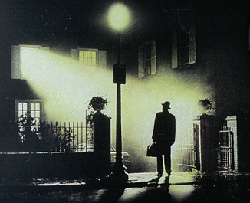
"Gooble gobble, gooble gobble. We accept her, we accept her."
This is one of the greatest films of all time, in my opinion, and one that could never be made today. The stars of this film are not the traditional screen gods and goddesses, but actual deformed, "abnormal" human beings. There's a guy known as the Human Torso, who's missing his arms and legs; there's a half-man/half-woman; there are conjoined twins, and other assorted people who have been rejected from society because of their physical defects.
Freaks was banned for a number of years and signaled the end of Browning's career, but it is a true masterpiece, a horror show with true insight, and one of those films that everyone should see at some point in their lives.
The basic story goes like this... Madame Tetrallini runs a circus and has taken in several of these so-called freaks. There are also several "normal" people in the circus, including Cleo, a beautiful trapeze artist. All the men in the circus are infatuated with Cleo, including a little person named Hans, who is actually engaged to another little person, Frieda. Hans starts sending Cleo gifts, and she accepts them sweetly to his face, but mocks him in private. Cleo eventually gets wind of the fact that Hans has a rather large inheritance and decides that she's going to marry him. Cleo and the circus' Strong Man, who have something going on behind Hans's back, plan to poison Hans after the wedding so that Cleo can get the money. The "freaks" find out about this plan - albeit too late to save Hans - and exact their revenge on Cleo and the Strong Man.
This is a really piercing look at humanity and the way we treat people who are not like us. The film makes you completely comfortable with the freaks. You see them as the normal people that they really are, and it's as if the "normal" people are the real freaks.
I don't think this would be considered a horror movie at all, were it not for the scene where the freaks get their revenge. The thing about that scene, though, is that the audience shares their desire for revenge. Even though what they do to Cleo is deeply disturbing (you don't actually see them do it, but you see what she looks like after), you can't help feeling they are justified in their retribution.
Excellent, excellent, excellent film. It's a shame that Browning wasn't able to do much more after Freaks, but the film is - in and of itself - a worthy career legacy.













